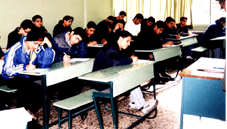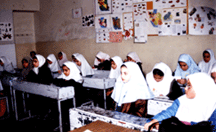A Brief Survey
Haroun Yashayaei

Building schools is a tradition in Iranian Jewish society with Iranians accustomed to building modern schools as old-fashioned educational systems change to modern ones.
However, even before they saw the necessity of building modern schools, Jews in Iran had the custom of sending their young people to religious institutes to receive training in various skills in addition to receiving religious instruction.
Over a century ago, Iranian Jews were already known to have established co-educational schools (called “Alliance” or “Ettehad”). They used modern teaching methods to educate students. The schools also availed of French teaching methods to teach their students. They built schools mostly in big cities where Jewish populations were bigger and there was a greater need for educational facilities.

The establishment of co-educational schools in Iran not only served to teach Iranian Jews modern educational skills but also in some way revolutionized Iranian Jewish society. The reason is that the co-educational schools that they established also took in Muslims who then became classmates of the Jewish students.
As a result of the new educational policy, Jews became familiar with Muslims and vice-versa. In fact, as self-made walls (like Ghettoes) that separated Iranian Jews and Muslims broke down, their horizons widened and Iranian Jews began seeing a country so dear to them during the past three centuries in a clearer perspective. Their eyes were opened to the opportunities for service to their country and nation.
Furthermore, Iranian Muslims began to get a closer view of Jewish society. They found that many old ideas about Jewish life and values that had been taught to them or handed down by ancestors were false. As a result of the good relations created between Jews and their Muslim compatriots, hate and prejudice slowly gave way. Since then, this reconciliation between Iranian Jews and their compatriots has been continuing as is evident in Islamic society.
Thus, the Jewish schools played a decisive role in forging such wholesome relations that was in fact the start of a new life for Iranian Jewish society.
The schools of “Ettehad,” “Kourosh” and “Ettefaqh” established in different cities had a tremendous influence in creating such a wholesome atmosphere. However, it should be mentioned here that it was the admission of male and female Jewish students in public schools that further strengthened this wholesome relationship.
However, it was in 1949 that Jewish society and Jewish-run schools began to experience tremendous changes. Jews in great numbers migrated from small cities to the big ones, specifically to Tehran. Many Jewish organizations in cities like Kashan, Broujerd, Sanandaj, Orumiyeh and Yazd disintegrated or closed down along with many Jewish schools.
Jewish parents were less attracted to Jewish schools in big cities, and preferred to send their children to study in public schools.
By 1971 Jewish immigration was so rampant and the Jews so widely dispersed, particularly in big cities, that the most important Jewish schools such as Etehad, Kourosh and, to some extent Etefaq, were faced with a crisis in student population and eventually had to close down.
However, after the victory of the Iranian Revolution and establishment of the Islamic Republic in 1979 schools for minorities and, in particular, several schools belonging to the Iranian Jewish society reverted to their former situation
After the revolution and approval of the new Iranian Constitution, the rights of minorities were respected and they were allowed to have their own schools on only one condition: that only minorities could be admitted in these schools that were to operate under the Ministry of Education.
Since the responsibility of running minority schools were placed by law in the hands of the Ministry of Education, they were able to operate more or less permanently. However, they were faced with a scarcity of students and, moreover, the quality of education in these schools was comparatively low.
Presently, there are only four Jewish educational institutes nationwide (in Tehran). As has been said, the main problem in these schools is the limited number of students. In addition, although certain educational perks are being provided such as transportation service, not to mention the comparatively big Jewish society in Tehran, the population of Jewish Iranians in Jewish schools remains dismally low.
At any rate, it should be noted that in spite of all the difficulties faced by Jewish schools in Tehran, they are rated as exemplary schools. The number of students entering different levels matches the usual national rate. This positive situation can only be attributed to the untiring efforts of dedicated teachers and staff of the Ministry of Education as well as the attention paid by families to the education of their kids in these schools which are run as private schools for minorities.
Educational programs for the next calendar year in Jewish private schools are decided upon during meetings attended by members of the schools' parent-teacher associations and also by education
specialists of the Cultural Committee of the Tehran Jewish Committee. Members of these associations meet from time to time to discuss various school issues. They are determined to use all their facilities to maintain high standards in Jewish schools in Tehran. Important decisions made during meetings of these Committees are to be notified to their board of directors, which is responsible for implementing them.
Jewish schools are allowed to operate in all levels and to maintain high standards of education in such a way as to attract quality students. They are also required to provide necessary facilities such as computerized systems and essential laboratories to assist in teaching.
Parent-teacher associations are required to be active and to have direct contacts with students' parents.
The schools' budgets should be determined before the start of any school year. Financial sources can be any of the following: 1) Students' tuition paid by parents at the time of enrolment in high schools, 2) A portion of revenues collected by synagogues to pay for the cost of maintaining schools that should detail the precise course of study and also the synagogue's annual commitment, 3) A budget allocation from the Tehran Jewish Committee requiring a specific obligation to be met by each school.
It may be worth mentioning here that all costs for training students in Hebrew religious duties, Jewish culture and values and a major portion of all other school expenses such as students' transportation are paid for by the Tehran Jewish Committee’s budget.
With the above discussion, it is the earnest hope of this community that Jewish private schools run by the Iranian Jewish society, specifically its students, parents, officials of synagogues and the Tehran Jewish Committee’s Board of Directors, would experience more successful years ahead as they continue to avail of the expertise and management of concerned teachers and managers.

